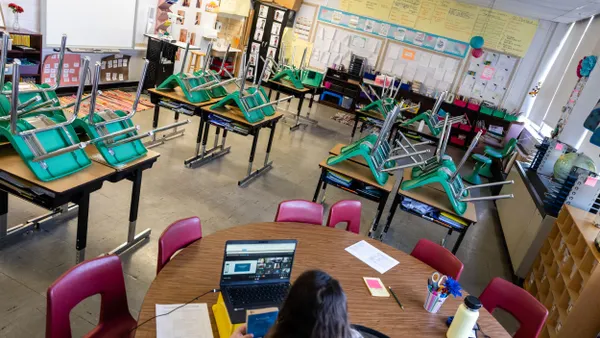Chris Yarrell is a staff attorney at the Center for Law and Education.
For over four decades, the Individuals with Disabilities Education Act has stood as a bulwark against discrimination, ensuring that students with disabilities have access to a free and appropriate public education in the least restrictive environment to the maximum extent appropriate.
This groundbreaking education law opened classroom doors long shuttered, empowering millions of young people to learn, grow and pursue their dreams alongside their peers.
Yet today, that hard-won progress must not be taken for granted. It is essential that Congress periodically reviews and updates the legislation to reflect current educational needs and best practices. The last major reauthorization of IDEA occurred in 2004, and as we approach the 20-year mark since that significant update, it is crucial for lawmakers to revisit and reauthorize the provisions of the IDEA. A failure to reauthorize this landmark legislation risks consigning an entire generation of students with disabilities to the injustice of lowered expectations and diminished opportunities.

Recent population data reveals a staggering 7.3 million students aged 3 to 21 relied on IDEA for vital specialized instruction and/or related services during the 2021-22 school year. This figure constitutes a full 15% of the nation’s public school population. Notwithstanding this large and growing population, a complex tangle of underfunding, teacher shortages and outdated policies has developed into a Gordian Knot for parents, practitioners and, ultimately, students with disabilities. If we are to uphold America’s promise as a land of equal opportunity for all, this wilting status quo cannot persist.
As our nation continues to reel from pandemic learning disruptions, a worsening teacher shortage crisis, and the escalating culture wars over public education’s very purpose, the stakes for students with disabilities have never been more dire. In classrooms and communities nationwide, their fundamental needs are too often overshadowed amid the political tumult.
While President Joe Biden’s administration has secured laudable wins for students with disabilities during his first term — from bolstering inclusive early childhood program access to deploying new academic recovery strategies — bolder, more decisive action is urgently needed to uphold IDEA’s legacy and secure its future. Three key reforms must be prioritized as Congress undertakes IDEA’s long overdue reauthorization:
Fully fund IDEA
When IDEA was originally passed in 1975, the federal government committed to covering up to 40% of the excess costs associated with providing special education and related services. Yet in the decades since, actual federal contributions have fallen woefully short — peaking at a mere 18-19% of the national average per-pupil expenditure.
By passing the IDEA Full Funding Act and incrementally ramping up allocations over the next decade, we can alleviate budgetary strain on school districts, reduce caseloads for overstretched special educators, improve academic outcomes, and enhance access to proven inclusive opportunities.
Closing teacher quality gaps
A top priority must be ensuring general education teachers receive comprehensive training on evidence-based practices for working with students with disabilities. In 2015, the Every Student Succeeds Act replaced the No Child Left Behind Act, changing or removing several provisions of IDEA in the process. Specifically, ESSA removed all references to the term “highly-qualified” for teachers and struck, by amendment, the definition of “highly-qualified” from IDEA.
Writing these more exacting standards back into IDEA is especially crucial for students with the most significant cognitive disabilities — a population that remains disproportionately siloed in segregated, highly restrictive settings. Indeed, a growing body of research indicates that while nearly two-thirds of students with less severe disabilities spend the majority of their day in inclusive general education classrooms, only 7% of students with the most significant cognitive disabilities experience comparable levels of inclusion.
By reinstating the “highly-qualified” teacher standards stripped from IDEA by ESSA, we can further equip our nation’s educators with the skills to make such substantive inclusion a reality.
Addressing chronic absenteeism
IDEA should be amended to include specific provisions for students who experience chronic absenteeism as a manifestation of their disability. Chronic absenteeism is a complex issue with far-reaching consequences. Students who miss substantial amounts of instructional time are at a higher risk of academic failure, disengagement from school, and ultimately, dropping out.
For students with disabilities, these risks are amplified, as their absences may be directly linked to the very challenges they face.
Currently, there are no explicit protections in IDEA for students who are truant, even when their absences are directly linked to their disability. This oversight has left a significant number of vulnerable children without the support they need to succeed academically, especially in the context of growing absences and drop-out rates that accrued among students with disabilities in the wake of the COVID-19 pandemic.
Consider the following example:
Imagine a student with severe anxiety or depression — conditions that can make simply getting out of bed and attending school an insurmountable task on some days. Under the current IDEA framework, these students can be punished for their absences, perpetuating a cycle of academic struggle and emotional distress.
It is time for IDEA to evolve and address this glaring gap in its protections. The statute should be amended to include specific provisions for students who experience chronic absenteeism as a manifestation of their disability. These protections should encompass two key elements: the right to not be punished for disability-related absences, and the right to receive “supplemental instruction” to catch up on the material missed during time away from the classroom.
The inclusion of “supplemental instruction” is a crucial distinction. By avoiding the term “compensatory”, we likely preclude the need for a finding of liability on the part of school districts. This approach acknowledges that absences can stem from factors beyond the control of educators, while still ensuring that students receive the support they need to bridge any academic gaps that may have arisen.
The path ahead is clear — by championing these three core reforms, our nation can breathe new life into IDEA’s promise as a bulwark for educational equity. Yet the stakes transcend policies, budgets and pragmatic outcomes. At its core, IDEA reauthorization represents a fundamental moral compact — one which tests our willingness to create an America where every child can access their infinite potential.
Comprehensive reforms like full federal funding, raising teacher quality standards, and safeguarding against discriminatory disciplinary practices are not just pragmatic solutions, but ethical imperatives reflecting our highest values as a nation. Reauthorizing and reinvigorating IDEA does more than sustain a legacy — it vaults open the doors of hope and possibility so every child can reach their highest horizon.



















